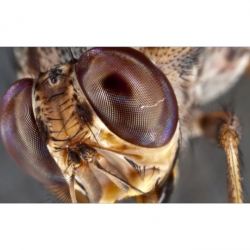As a scientist, I frequently get asked questions about topics that people bump into in their everyday lives.
- WIll the flu shot give me the flu? (no)
- Should I buy a crib bumper? (no)
- Are you worried about GMOs? (absolutely not)
In a conversation recently with someone who had recently been on safari, the topic was the tsetse fly. This person had been told to not wear dark (blue or black, specifically) clothing because he was told that the tsetse was drawn to dark colors. In fact - this is such a widely accepted piece of information that, on the cdc website, the second tip for avoiding tsetse fly bites is
"Wear neutral-colored clothing. The tsetse fly is attracted to bright colors, very dark colors, metallic fabric, and the color blue."
People who live in or are traveling to sub-saharan Africa avoid tsetse flies because they bite, and can transmit the parasite Trypanosoma brucei which causes human African trypanosomiasis (HAT,) also referred to as African sleeping sickness. There are roughly 10,000 cases of sleeping sickness reported to the WHO every year, although that number is thought to be a gross underestimate of the actual number of cases. Symptoms include fatigue, high fever, headaches, and muscle aches. If the disease is not treated, it can cause death.

Many insects, including some species of tsetse, are attracted to specific odors. However, the riverine tsetse (the particular tsetse that is responsible for spreading sleeping sickness) does not. Because of this, other senses have to be employed for luring them to traps to reduce transmission of disease. So, pieces of insecticide soaked dark fabric are hung in the wild in sub-Saharan Africa, to attract the tsetse flies. But, do these really work? And, how do we know that a tsetse is attracted to dark colors in the first place?
Looking into one research paper published in PLOS Tropical Neglected Diseases gives us a window into the type of experimentation that backs up this claim. A group from both the UK and South Africa investigated the optimal target color to attract the tsetse fly.
To do this, they conducted studies on the riverine species of tsetse on Chamaunga Island of Lake Victoria, Kenya using 37 different colored squares (25cm) of fabric to measure which color attracted the most tsetse. The fabric squares also contained an electrocuting grid that would create any tsetse that touch the fabric to fall down into a tray of soapy water, so that they could be counted. The group performed 15 different experiments, each at the time of day when tsetse are most active - 9:00 am and 1:00 pm. After much tsetse counting and number crunching, the conclusion will make you pack khakis for your next safari.
The tsetse were, indeed, most attracted to blue fabrics, with the very specific phthalogen blue leading the pack, followed by black and reds and green-yellow coming in as least attractive.
But, why are tsetse flies attracted to blue and black colors? What is the evolutionary advantage for them? It has been hypothesized that certain areas on humans, where tsetse like to bite, are a darker shade. Or, that the dark color simply identifies the object as not plants.
Whatever the reason, the data are there to support the idea that the tsetse is, in fact, drawn to blue and black colors and that wearing neutral colors is helpful in an effort to stay free from African sleeping sickness. And, this information is not only interesting, but highly important. Insects that transmit disease are a major health threat across the globe, from ticks that transmit Lyme's disease to the Aedes aegypti mosquito that carries yellow fever, Zika and Dengue fever. Decreasing their populations by designing improved trapping methods requires a thorough understanding of their fundamental biology.
Notes:
1) The photograph of the tsetse eye was taken by Geoffrey M. Attardo, a scientist who studies the reproduction of insect, and was selected as Image of the Year by the John E. Fogarty International Center.

